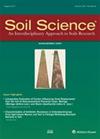模拟链位置和水文对土壤化学风化的影响
4区 农林科学
Q2 Agricultural and Biological Sciences
引用次数: 5
摘要
摘要化学风化对气候和侵蚀强迫的敏感性在区域尺度上得到了很好的证实。然而,众所周知,土壤形成在地形、水文和植被导致土壤性质和可能的化学风化差异的链带上变化很大。本研究应用SoilGen模型来评估地形位置和水文之间的联系,以及西班牙南部南北连接线土壤剖面的化学风化。在2万年的时间里,在7个选定的地点测量和模拟了成土作用。模拟和测量的化学耗损分数(CDF)具有良好的对应关系(R2 = 0.47)。观察到CDF值沿链的重要变化,尽管沿链的位置单独,而不是斜坡梯度,很好地解释了这种变化。然而,水文变量更好地解释了观测到的趋势。CDF数据与土壤水分和入渗呈正相关,与水停留时间呈负相关。在大降水梯度(200-1200 mm yr - 1)下评估了模型的敏感性。当降水量达到800 mm yr - 1时,CDF的深度梯度明显,而当降水量超过800 mm yr - 1时,CDF的深度分布均匀。化学风化对降水响应的基本模式是单峰曲线,在年平均降水量800 mm yr−1附近有最大值。有趣的是,这证实了其他土壤性质与降水关系的类似发现,应该在进一步的研究中进行探索。本文章由计算机程序翻译,如有差异,请以英文原文为准。
Modelling the effect of catena position and hydrology on soil chemical weathering
Abstract. The sensitivity of chemical weathering to climatic and erosional forcing is well established at regional scales. However, soil formation is known to vary strongly along catenas where topography, hydrology, and vegetation cause differences in soil properties and possibly chemical weathering. This study applies the SoilGen model to evaluate the link between topographic position and hydrology with the chemical weathering of soil profiles on a north-south catena in southern Spain. Pedogenesis was measured and simulated in seven selected locations over a 20000-year period. A good correspondence between simulated and measured chemical depletion fraction (CDF) was obtained (R2 = 0.47). An important variation in CDF values along the catena was observed, although the position along the catena alone, nor by the slope gradient, explained this variation well. However, the hydrological variables explained the observed trends better. A positive trend between CDF data and soil moisture and infiltration and a negative trend with water residence time was found. The model sensitivity was evaluated with a large precipitation gradient (200–1200 mm yr−1). While a marked depth gradient was obtained for CDF with precipitation up to 800 mm yr−1, a uniform depth distribution was obtained with precipitation above 800 mm yr−1. The basic pattern for the response of chemical weathering to precipitation is a unimodal curve, with a maximum around a mean annual precipitation value of 800 mm yr−1. Interestingly, this corroborates similar findings on the relation of other soil properties to precipitation and should be explored in further research.
求助全文
通过发布文献求助,成功后即可免费获取论文全文。
去求助
来源期刊

Soil Science
农林科学-土壤科学
CiteScore
2.70
自引率
0.00%
发文量
0
审稿时长
4.4 months
期刊介绍:
Cessation.Soil Science satisfies the professional needs of all scientists and laboratory personnel involved in soil and plant research by publishing primary research reports and critical reviews of basic and applied soil science, especially as it relates to soil and plant studies and general environmental soil science.
Each month, Soil Science presents authoritative research articles from an impressive array of discipline: soil chemistry and biochemistry, physics, fertility and nutrition, soil genesis and morphology, soil microbiology and mineralogy. Of immediate relevance to soil scientists-both industrial and academic-this unique publication also has long-range value for agronomists and environmental scientists.
 求助内容:
求助内容: 应助结果提醒方式:
应助结果提醒方式:


